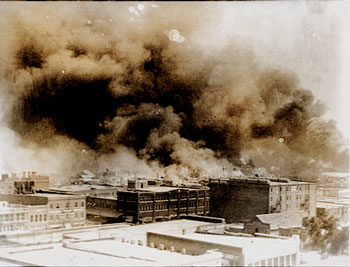Reflections of the Tulsa Resistance of 1921
By Lloyd C. Daniel | Last updated: Jun 22, 2006 - 10:39:00 PMWhat's your opinion on this article?

Historic photo of smoke billowing over Tulsa, Oklahoma during 1921 race riots.
|
Then, the entire Black community became the target. White marauders besieged the Black area of North Tulsa, which was at that time, one of the most prosperous Black communities in the United States. But the Blacks’ unexpectedly high degree of paramilitary sophistication and bravery stunned the White population of Tulsa, as it did Whites throughout the region. The Blacks’ swift and tactically sound strategy won a brief moral and military victory for the resistance against the local police force, over 3,000 members of the Ku Klux Klan and other White men.
The Black community in North Tulsa was called “Little Africa” by local White newspapers, and included the Black business district referred to as “Black Wall Street.” The district was called Black Wall Street because over 600 Black-owned businesses flourished, including banks, oil, insurance, real estate companies, lawyers’ and doctors’ offices, libraries, hospitals, hotels, schools, theatres and restaurants.
Eventually, the combined forces of the White power structure, including the National Guard, overwhelmed the Black resistance fighters, led by the African Blood Brotherhood and others. After the resistance ended, a massacre ensued. Hundreds of Black men were rounded up and held illegally for fighting for their families’ lives. Many were murdered by bludgeoning, hanging and firing squads. Black Wall Street was completely burned to the ground by the White mob.
Thousands of Whites, accompanied by the National Guard, looted Black homes and set them afire, as they moved on with a scorched earth policy, to teach the Blacks a lesson. The community was obliterated. More than 10,000 Black people were left homeless. As the Black citizens of Tulsa fled, with literally nothing but the clothes on their backs, they were bombed from the air by a biplane that dropped turpentine bombs, the forerunner of napalm. Bodies were dumped in the Arkansas River and others were burned at mass gravesites.
This happened to a community that was, at that time, one of the most prosperous Black communities in the United States. This fact fueled the mobs’ fury. Their jealousy, envy, hatred and fear were at the root of their madness.
Most of those who were there in 1921 have passed on. But the State of Oklahoma, pressed by the Oklahoma Legislative Black Caucus, agreed to a reparation settlement for survivors of the ethnic cleansing operation that occurred. Based upon my own research and study, I know this account to be true. But I also cherish the eyewitness accounts I have heard over the years from my elders.
You see, my grandparents and their three sons were there. My grandfather Harry Daniel, a former slave who had been disarmed, and his wife Ella watched as members of the National Guard looted and set fire to their business, Daniel’s Sundries. Their home had already been looted and burned by a mob. Their middle son, Cecil, was my father. The men and boys of North Tulsa fought bravely. They lost all but their families and their dignity. This part of my family survived, lived to tell what really happened and established new roots in Kansas City, Missouri.
Related news:
CBC panel hears Tulsa ‘massacre’ victims’ appeal (FCN, 06-01-2005)
Landmark suit seeks reparations for deadly 1921 Okla. riot (FCN, 03-13-2003)
INSIDE STORIES AND REVIEWS
-
-
About Harriett ... and the Negro Hollywood Road Show
By Rabiah Muhammad, Guest Columnist » Full Story -
Skepticism greets Jay-Z, NFL talk of inspiring change
By Bryan 18X Crawford and Richard B. Muhammad The Final Call Newspaper @TheFinalCall » Full Story -
The painful problem of Black girls and suicide
By Charlene Muhammad -National Correspondent- » Full Story -
Exploitation of Innocence - Report: Perceptions, policies hurting Black girls
By Charlene Muhammad -National Correspondent- » Full Story -
Big Ballin: Big ideas fuel a father’s Big Baller Brand and brash business sense
By Bryan Crawford -Contributing Writer- » Full Story






 Click Here Stay Connected!
Click Here Stay Connected!








